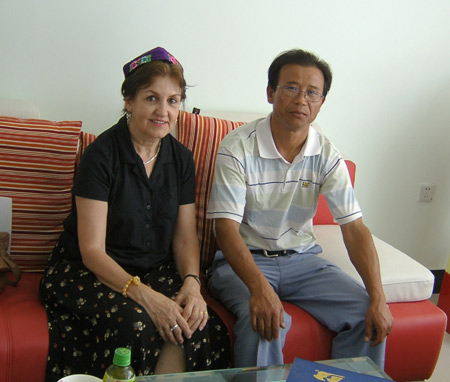By Lisa Carducci
It was by chance that I met Gendengjiap, 38, a Mongol from Hejing County in Bayangol Mongol Autonomous Prefecture who had been one of Lindai's students. Gendengjiap explained that he didn't paint anymore. After 13 years of this trade, he started a little business besides practicing charity. He makes items from goat, yak, and Tibetan antelope horns. Don't worry, he doesn't kill the animals but collects carcasses that people find in the mountains and take to him.
|

|
|
Lisa(L) and Gendengjiap(R) [Foreign Languages Press] |
He also has wolves, which was what first attracted me to Gendengjiap's shop. While strolling on the pedestrian street that opened in Hejing two years ago, I saw three superb beasts made of synthetic material and covered with real wolf skin. Two of them still had their teeth. The eyes? One would believe that they are the original owners'. I have always admired this social, intelligent animal, which is so badly known and maligned because of ignorance and prejudice. In defence of the wolf, I wrote a children's story – not off limits to adults! – where a mother wolf asks a goat for help and these traditional enemies thus finally become friends. Published by the Canadian Hurtubise publishing house, Chèvres et Loups was later converted into a 24-minute animation by China Central Television. I also have recently translated Jiang Rong's The Wolf Totem into French. I absolutely wanted to own something of the wolf to feel closer to it, for instance, a wolf fang that was in the shop. I made my choice at the counter, and, at the end, Gendengjiap generously offered it to me.
In the shop I could see goat skulls, a yak head, and several ornamental "paintings" composed from horn pieces of different colors. One of them won a national award. They sell for about 800 yuan (80 euros or 100 dollars), and tourists like them but the pictures are difficult to transport. Gendengjiap knows that, since he is the local Tourism Office director. Every evening, after office hours, he works until midnight, planning the workers' jobs for the following day.
Presently, Gendengjiap has six employees, all young men, who have been with him for six months to three years. The youngest is 16. They are all high school graduates who could not find work and they learn the trade at a pace according to their aptitudes. Some need six months; others, one year. They work eight hours a day from 10:00 to 13:30 and from 17:00 to 21:00 or 22:00. This is a normal timetable in Xinjiang, where the summer is very hot and where there is a two-hour gap with Beijing time.
Gendengjiap invested a great deal in this enterprise. He gives his employees not only their salaries but accommodation, meals, and social security. All profits are rolled over into his business.
The little shop produces goods in four categories. First, articles with a Return-to-the-East theme, a historical event that rightly belongs to the Hejing Mongol community to exploit. Second, things related to the Mongol nomadic and rural life, such as kitchenware or equine gear. Third, articles belonging to the Junggar Mongol tribe, though Gendengjiap is Turgut, that aim to perpetuate and proliferate Mongol history. And, finally, local souvenirs, which sell the best because of their small size and weight, such as woven bags, antelope-horn rings, incense burners, and hadas (silk) from Tibet.
Hejing is very pleasant, though not a destination place, but, rather, a place where one passes through to go somewhere else. The reason is that its tourism attractions are not that convenient to reach. The closest, according to the Tourism Office's director, is the Baluntai Temple of the Tibetan Buddhism's Yellow sect, 60 km away, and the most distant is the vast prairie that everyone talks about in Xinjiang but that few have seen, and Swan Lake, both 300 km away.
Also, the tourism high season is short and only lasts from July to September, explained Gendengjiap. In winter, the temperature is -20oC on the plain and -40oC in the mountains, and all is covered with snow. Few foreigners visit Hejing, but in June this year, 20 tourists came from the United States. In 2008, the road to the mountain will be passable and tourism will surely benefit from this. Already, some holiday villages (Dujiacun) and about 30 rural families welcome tourists. Visitors can stay in these households, which have all been accredited, and participate in daily rural life. They can ride horses or even yaks, and the animals are kept in reins. Song and dance performances are performed with visitors in mind. When I asked how many days on average the tourists stay in the Mujiale (herdsman's family) and Nongjiale (farmer's family), Gendengjiap answered, "No, not days, only hours.... They have lunch and leave." He added, "Our principle – and I often repeat it to the authorized peasant households – is, 'The tourists arrive here happy; they must leave happier'."
(Source: Foreign Languages Press)